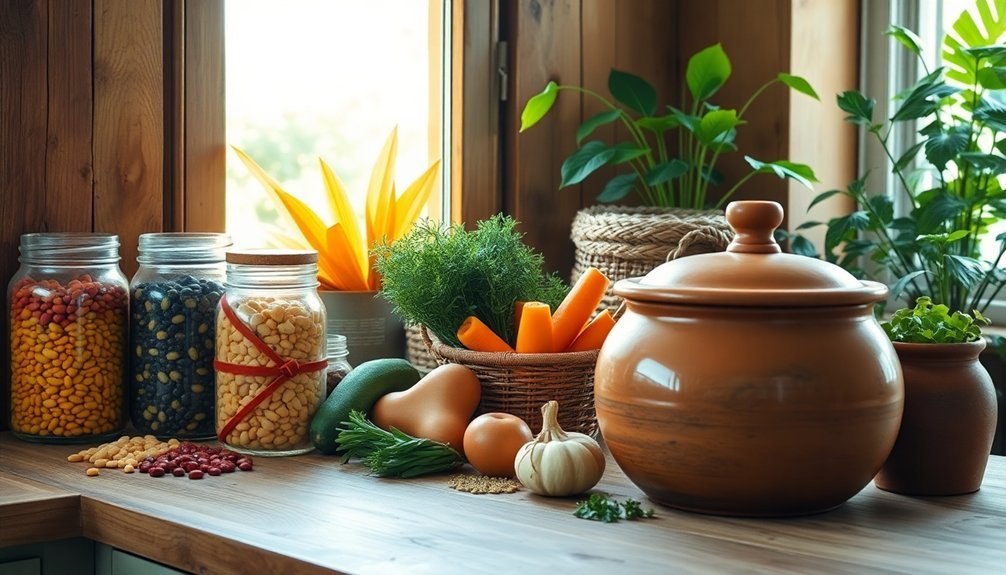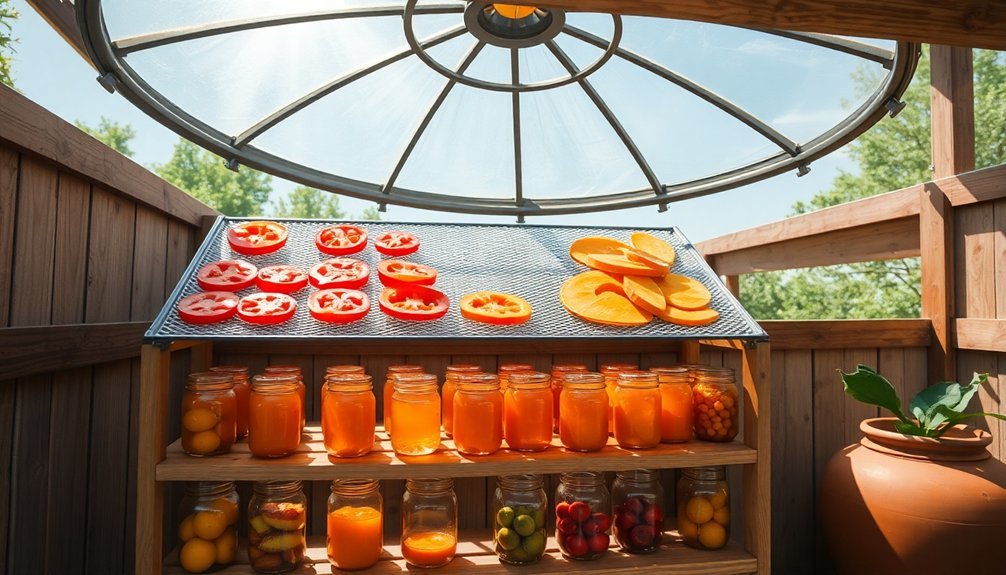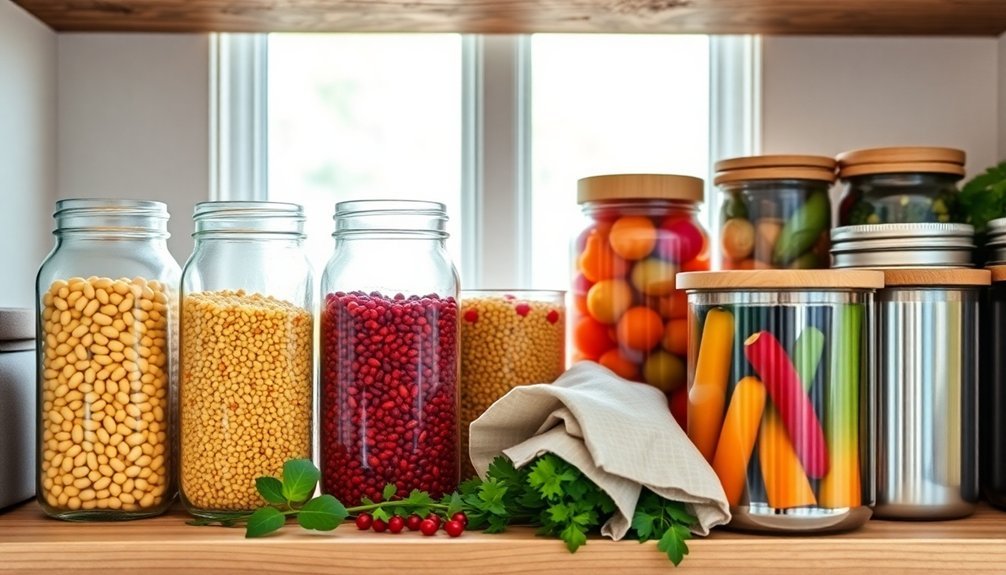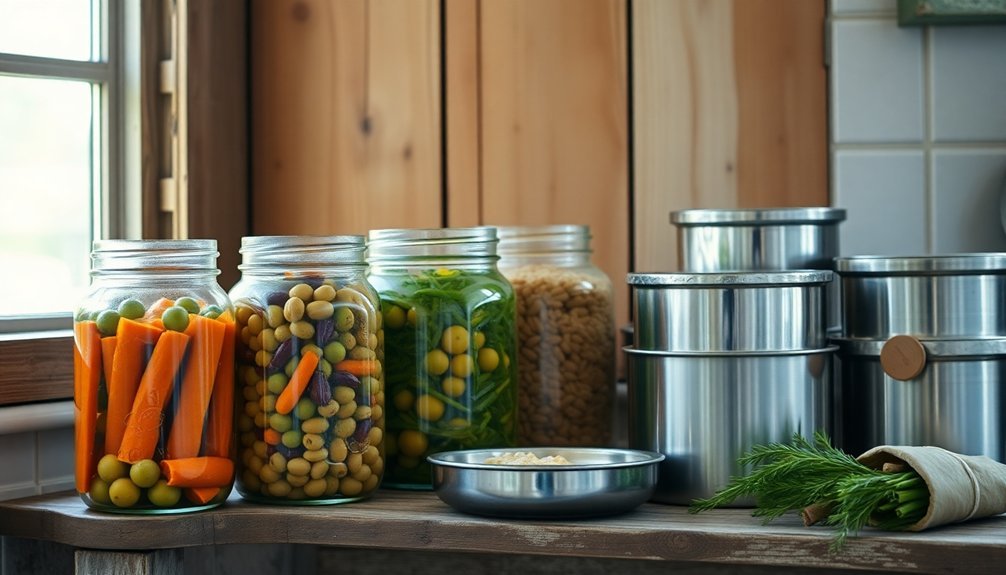Natural food storage methods work best when you match the right eco-friendly container with your food type. Glass and stainless steel provide airtight seals for longer freshness, while breathable cotton bags help produce stay crisp. You'll find beeswax wraps excellent for cheese and snacks, and biodegradable starch containers work well for meat and fish. Solar drying preserves nutrients while eliminating electricity costs. Smart features like proper ventilation, stackable designs, and food-grade materials guarantee your items stay fresh without harming the environment. Discover how these earth-conscious choices can transform your kitchen storage routine.
Natural Materials for Food Storage

Nature's solutions for food storage have evolved far beyond traditional plastic containers.
You'll find biodegradable starch-based materials made from corn that are BPA-free and perfect for storing meat and fish in your fridge. These sustainable bags can be stored for optimal use when kept in cool, dry places. Plant-based packaging offers leak-resistant options that are both compostable and recyclable, helping you reduce fossil fuel consumption.
Looking for durability? Bamboo provides heat-resistant storage solutions like countertop jars and lunch boxes, though they may show wear faster than glass or steel alternatives.
You can also explore innovative options like rice husk containers, which turn farming byproducts into practical storage solutions. For food safety, gelatin films with antimicrobial properties keep your food fresh while meeting FDA standards.
Even sugarcane and wheat straw have found their way into containers suitable for both hot and cold foods.
Keeping Food Fresh Without Plastic
Beyond natural packaging materials, you'll find numerous practical alternatives to plastic food storage that keep ingredients fresh while protecting our environment.
Glass and stainless steel containers with airtight seals maintain food quality longer, while beeswax wraps offer a biodegradable solution for produce and snacks. Making this switch could help reduce the 4.5 million tonnes of food waste produced by UK households annually.
You can revolutionize your kitchen storage with these eco-friendly options:
- Use silicone storage bags and bowl covers that create perfect seals for both wet and dry ingredients.
- Protect cut fruits and vegetables with food huggers, which extend shelf life by preventing oxidation.
- Store produce in breathable cotton bags that maintain proper airflow while keeping items fresh.
These alternatives aren't just sustainable – they're also durable, non-toxic, and often dishwasher safe, making them practical for daily use.
Solar Preservation Methods That Work

Solar food preservation stands as one of the most sustainable and cost-effective methods for extending your food's shelf life. You'll find that solar drying not only saves energy but also enhances your food's natural flavors while retaining essential nutrients. Local materials and resources make this preservation method accessible to communities worldwide.
| Solar Benefits | What You Get |
|---|---|
| Energy Savings | No electricity costs, reduced carbon footprint |
| Better Nutrition | 15-20% moisture retention, preserved vitamins |
| Enhanced Flavor | Concentrated tastes, natural color preservation |
| Food Security | Extended shelf life, emergency food supply |
Earth-Conscious Container Selection Guide
Choosing the right containers for food storage goes hand in hand with sustainable preservation methods.
You'll find that materials like glass, stainless steel, and food-grade silicone offer the best combination of durability and eco-friendliness. These materials don't leach chemicals or create harmful waste, making them ideal for your kitchen. Products like Vejibags can keep fruits and vegetables fresh for over two weeks when stored properly.
For peak food preservation, look for these essential features:
- Airtight seals to maintain freshness and prevent spoilage
- Stackable designs that maximize your storage space
- Proper ventilation options for produce that needs to breathe
Consider your storage environment when selecting containers.
Glass and ceramic work well for both refrigeration and room-temperature storage, while breathable cloth bags are perfect for produce that requires air circulation.
Sustainable Storage Success Stories

Leading food companies have demonstrated remarkable success in sustainable storage and operations, proving that eco-friendly practices can benefit both the environment and the bottom line.
You'll find impressive examples like Campbell Soup's California plant, which cut electricity use by 4.85% and water consumption by 13.45% per pound of product through smart metering and efficient nozzles.
They'll save an additional $500,000 yearly with new heat recovery systems.
Kraft Foods shows what's possible by storing products in natural limestone caves, using 65% less energy than conventional facilities.
Meanwhile, Bumble Bee Foods transformed their transportation strategy, saving 900,000 gallons of diesel fuel through optimized loading and intermodal shipping.
Their direct-from-plant deliveries and fixed-day scheduling have cut CO2 emissions by over 10,000 metric tons.
Food Safety in Green Containers
While major companies optimize their storage facilities, individual consumers need safe and eco-friendly food containers for daily use.
Today's green containers blend safety with sustainability, using biocomposite materials like rice husk and bamboo waste mixed with food-safe polypropylene. You'll find these containers are free from harmful chemicals like BPA and formaldehyde, ensuring your food stays uncontaminated.
For ideal food safety in eco-friendly containers, follow these key practices:
- Store raw foods at the bottom of your fridge in sealed containers to prevent cross-contamination
- Keep high-risk foods below 5°C or above 60°C to avoid the temperature danger zone
- Transfer opened canned goods into airtight containers immediately
Your containers should have secure, impact-resistant lids and tight seals to maintain freshness while being microwave and dishwasher safe for convenient cleaning.
Future of Eco Storage Solutions

As technology and environmental awareness converge, the future of eco-friendly storage solutions promises groundbreaking innovations.
You'll see more IoT-enabled containers that monitor your food's freshness while using sustainable materials like bamboo or plant-based plastics.
Blockchain technology will transform how you track your food's journey from farm to table, ensuring safety and reducing waste.
Smart storage systems will use AI to maintain ideal conditions, while community-based initiatives will make sustainable storage more accessible through shared facilities and educational workshops.
You'll find yourself embracing zero-waste living with innovative solutions like edible packaging and mushroom-based containers.
These advancements, combined with improved buying and storage habits, will help you reduce your environmental footprint while keeping your food fresh and safe.
Frequently Asked Questions
Can Eco-Friendly Containers Survive Being Dropped or Knocked Over Repeatedly?
Yes, you'll find eco-friendly containers, especially reusable ones made of stainless steel, can withstand repeated drops and impacts. While biodegradable options are less durable, they're still designed to handle basic transportation stress.
How Do Different Altitudes Affect Food Preservation in Sustainable Containers?
You'll need stronger seals at high altitudes since pressure changes can affect your eco-containers. Watch for expansion, seal failures, and altered boiling points that impact food safety and preservation methods.
Do Sustainable Food Containers Change the Taste of Spicy Foods?
You won't notice any taste changes in your spicy foods when using sustainable containers. In fact, you might find them more enjoyable since the eco-friendly packaging doesn't leach chemicals and enhances your perception of quality.
What Happens to Eco-Friendly Containers Exposed to Extreme Temperature Fluctuations?
You'll notice biodegradable containers can break down faster with temperature swings. While bagasse stays strong from -13°F to 428°F, PLA containers might warp or melt above 140°F. Metal and glass remain most stable.
Can Sustainable Containers Be Effectively Sterilized Without Damaging Their Properties?
Yes, you can safely sterilize sustainable containers using methods like radiation, peroxide treatments, or steam autoclaving. You'll need to match the sterilization technique to your container's material to preserve its eco-friendly properties.
In Summary
You've got plenty of earth-friendly options to keep your food fresh while protecting the planet. Whether you're using clay containers, beeswax wraps, or solar preservation methods, you'll find these sustainable choices work just as well as plastic. By selecting natural materials and following proper food safety guidelines, you're not only preserving your food but also contributing to a healthier environment. Keep exploring new eco-storage innovations as they emerge.





Leave a Reply